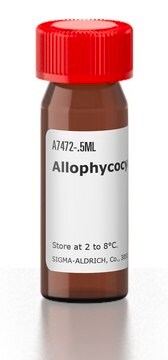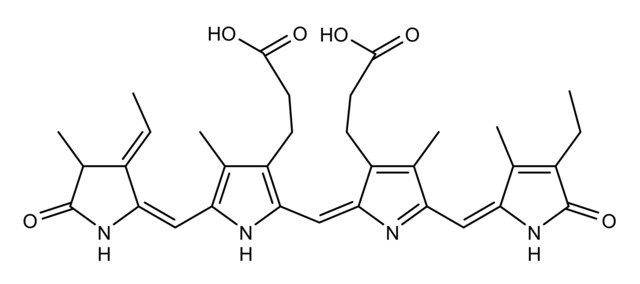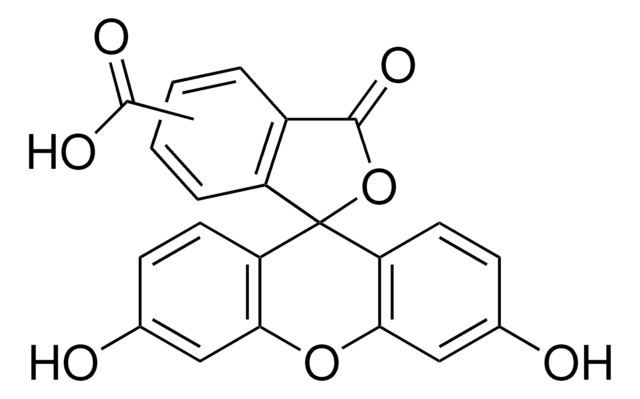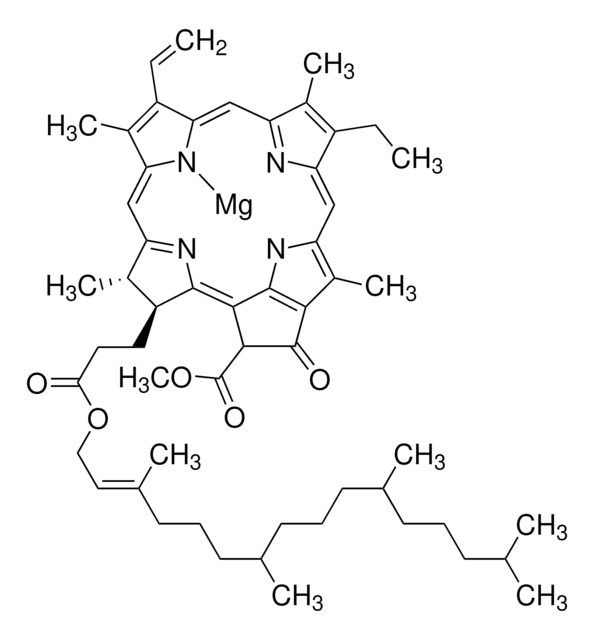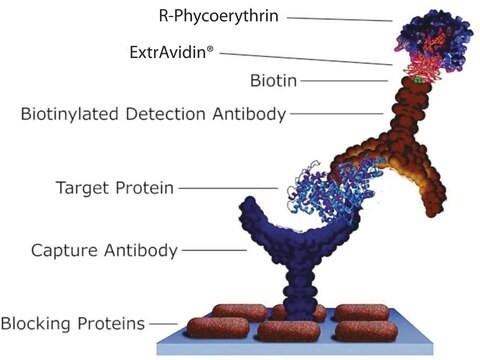52412
R-Phycoerythrin
BioReagent, passes test for gel electrophoresis
Sinónimos:
R-PE, phycobiliprotein
Iniciar sesiónpara Ver la Fijación de precios por contrato y de la organización
About This Item
Productos recomendados
Línea del producto
BioReagent
Nivel de calidad
concentración
≥10.0 mg/mL (UV)
técnicas
electrophoresis: suitable
fluorescencia
λex 542 nm; λem 575 nm in 0.1 M phosphate pH 7.2
idoneidad
passes test for gel electrophoresis
temp. de almacenamiento
2-8°C
Categorías relacionadas
Descripción general
R-Phycoerythrin or R-PE is a fluorescent probe belonging to the group of phycobiliproteins obtained from macroalgae. R-Phycoerythrin (R-PE) is a protein acting as a photosynthetic accessory pigment in red algae (Rhodophyta). It is an oligomeric protein of 240 kDa, with 6 α (about 20 kDa), 6 β (about 20 kDa), and 1 γ (about 30 kDa) subunits. Phycobiliproteins are water-soluble light-harvesting proteins with a high fluorescent property.
Aplicación
R-Phycoerythrin (R-PE) is useful in the laboratory as a fluorescence-based indicator for the presence of cyanobacteria and a variety of immunofluorescence applications. R-PE is a useful fluoroprobe in various electrophoretic procedures. R-Phycoerythrin (R-PE) proteins detect mercury ions in soil and groundwater samples. Phycoerythrin has been widely used in food, cosmetics, immunodiagnostics, and analytical reagents.
Nota de análisis
The product is suspended in 150 mM sodium phosphate, 60% ammonium sulfate, 1 mM EDTA, 1 mM sodium azide, pH 7.0 and must be dialyzed against conjugation buffer or PBS before conjugation.A566/A280 >4.6, A620/A566 <0.03, A566/A498 <1.5
¿No encuentra el producto adecuado?
Pruebe nuestro Herramienta de selección de productos.
Código de clase de almacenamiento
12 - Non Combustible Liquids
Clase de riesgo para el agua (WGK)
WGK 1
Punto de inflamabilidad (°F)
Not applicable
Punto de inflamabilidad (°C)
Not applicable
Equipo de protección personal
Eyeshields, Gloves
Elija entre una de las versiones más recientes:
¿Ya tiene este producto?
Encuentre la documentación para los productos que ha comprado recientemente en la Biblioteca de documentos.
Los clientes también vieron
Xuefei Sun et al.
Journal of chromatography. A, 1216(1), 159-164 (2008-12-17)
Electric field gradient focusing (EFGF) is a technique used to simultaneously separate and concentrate biomacromolecules, such as proteins, based on the opposing forces of an electric field gradient and a hydrodynamic flow. Recently, we reported EFGF devices fabricated completely from
Joerg Martini et al.
Lab on a chip, 12(23), 5057-5062 (2012-10-10)
We describe an optical detection technique that delivers high signal-to-noise discrimination to enable a multi-parameter flow cytometer that combines high performance, robustness, compactness and low cost. The enabling technique is termed "spatially modulated detection" and generates a time-dependent signal as
Kun Tang et al.
Biochimica et biophysica acta, 1817(7), 1030-1036 (2012-04-03)
Phycobilisomes, the light-harvesting antennas in cyanobacteria and red algae, consist of an allophycocyanin core that is attached to the membrane via a core-membrane linker, and rods comprised of phycocyanin and often also phycoerythrin or phycoerythrocyanin. Phycobiliproteins show excellent energy transfer
Radek Sachl et al.
Biophysical journal, 101(11), L60-L62 (2012-01-21)
Even though superresolution microscopy indicates that size of plasma membrane rafts is <20 nm, those structures have never been observed. Förster resonance energy transfer (FRET) is therefore still the most powerful optical method for characterization of such domains. In this letter
David Rizzo et al.
Cytometry. Part B, Clinical cytometry, 84(2), 125-132 (2012-12-12)
Flow cytometry is the reference technique for assessing ZAP70 expression, a marker of poor prognosis in CLL. One of the most common methods is to assess ZAP70 levels in CLL cells by calculating the ratio between ZAP70 mean fluorescence intensities
Nuestro equipo de científicos tiene experiencia en todas las áreas de investigación: Ciencias de la vida, Ciencia de los materiales, Síntesis química, Cromatografía, Analítica y muchas otras.
Póngase en contacto con el Servicio técnico
